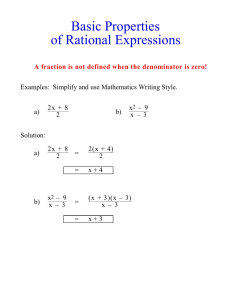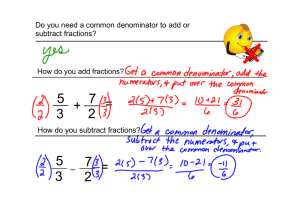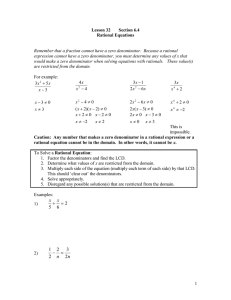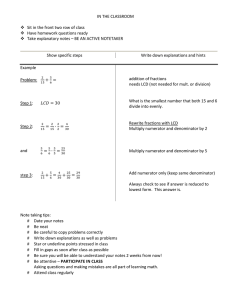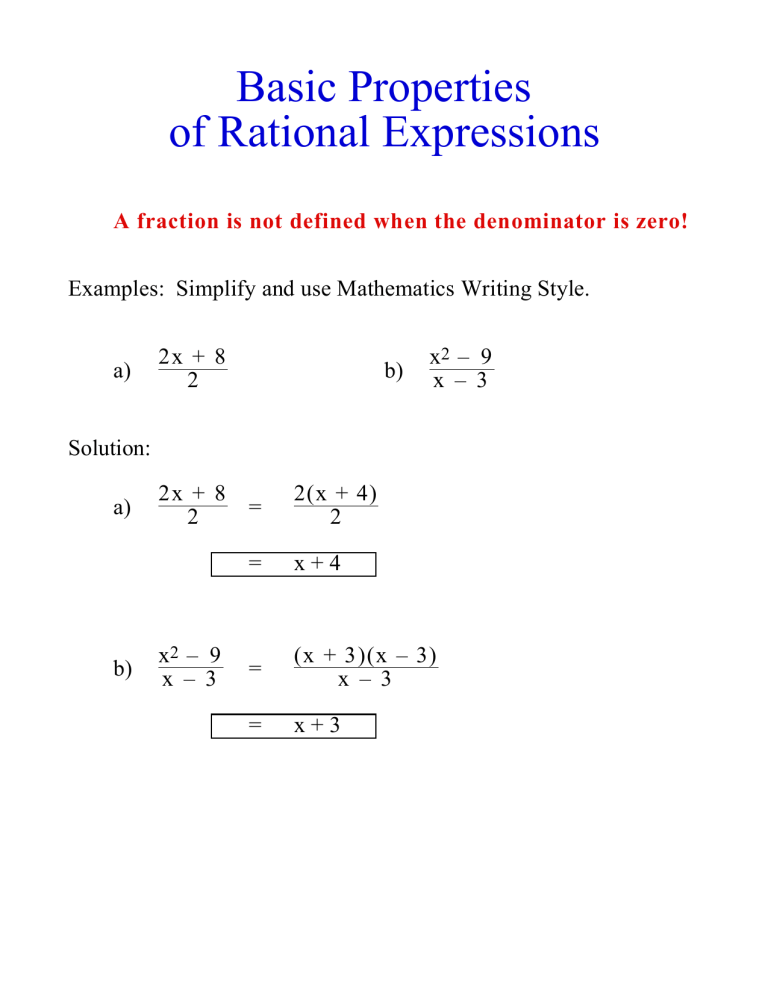
Basic Properties
of Rational Expressions
A fraction is not defined when the denominator is zero!
Examples: Simplify and use Mathematics Writing Style.
a)
2x + 8
2
b)
x2 – 9
x – 3
Solution:
a)
b)
2x + 8
2
x2 – 9
x – 3
=
2(x + 4)
2
=
x+4
=
(x + 3)(x – 3)
x – 3
=
x+3
The Domain of a Rational Function:
Examples: Find the domain of the following functions:
x + 5
a) f(x) = 2x + 4
b) g(x) = x – 4
2x + 5
x
c) h(x) = 3
d) F(x) = 2
x – 4x
x + 9
Solution:
a) f(x) = 2x + 4
This is a polynomial, and
is defined for all values of x.
So the domain is the set of real
numbers.
D=R
x + 5
b) g(x) = x – 4
This is a rational function
and is not defined when the
denominator is zero, or when
x–4
= 0
x
= 4
So the domain is consists of all
real numbers except that.
D = {x ∈ R | x ≠ 4 }
2x + 5
x3 – 4 x
This is a rational function
and is not defined when the
denominator is zero, or when
x3 – 4x
= 0
x(x2 – 4)
= 0
x(x –2)(x + 2) = 0
x
= 0, 2, –2
So the domain is consists of all
real numbers except these.
c) h(x) =
D = {x ∈ R | x ≠ 0, 2, –2 }
x
x2 + 9
This is a rational function
and is not defined when the
denominator is zero, or when
x2 + 9
= 0
d) F(x) =
But this expression is never
zero for any real value of x. So
the domain consists of all real
numbers.
D=R
Multiplication and Division of
Rational Expressions
Example: Perform the indicated operation and simplify:
x2 + 2 x – 3
4x + 2
2x2 – 9 x – 5
÷ 2
• 2
x2 – 3 x – 1 0
x – x
x – 2x + 1
=
x2 + 2 x – 3
x2 – x
2x2 – 9 x – 5
• 4x + 2 • 2
x2 – 3 x – 1 0
x – 2x + 1
=
(x + 3)(x – 1)
x(x – 1)
(2x + 1)(x – 5)
•
•
(x – 5)(x + 2)
2(2x + 1)
(x – 1) 2
=
x(x + 3)
2(x + 2)
Adding or Subtracting
Fractions with Equal Denominators
Examples: Perform the indicated operation and simplify:
x
2
+
x2 – 4
x2 – 4
a)
=
x + 2
x2 – 4
b)
x2
4x – x 2
– 2
x2 – 4
x – 4
x2 – ( 4 x – x 2)
=
x2 – 4
x + 2
= (x + 2)(x – 2)
x2 – 4 x + x 2
=
x2 – 4
1
= x – 2
2x2 – 4 x
=
x2 – 4
2x(x – 2)
= (x + 2)(x – 2)
2x
= (x + 2)
Finding the LCD
Step 1.
Factor each denominator completely, including the
prime factors of any constant factor.
Step 2. Form the product of all the factors that appears in the
complete factorizations.
Step 3. The number of times any factors appears in the LCD is
the most number of times it appears in any one
factorization.
Examples: Find the LCD for the given denominators:
a) Denominators are 24, 30, and 36
24
=
8•3
=
23 • 3
30
=
6•5
=
2•3•5
36
=
4•9
=
22 • 3 2
LCD
=
23 • 3 2 • 5
=
360
b) Denominators are x3 – x 2 and x3 – x
x3 – x 2
x3 – x
=
x(x2 – 1)
LCD
=
x2(x – 1)
=
x(x + 1)(x – 1)
=
x2(x + 1)(x – 1)
Adding or Subtracting
Fractions with Unequal Denominators
(FLEAS)
Factor the rational expression.
2. Find the Least Common Denominator (LCD).
3. Equalize each denominators by replacing each fraction
1.
with an equivalent one whose denominator is the LCD.
4.
Add or Subtract using RASFED.
Example:
1
2
3
–
+
2
3
4
=
6
8
9
–
+
12
12
12
=
6 – 8 + 9
12
=
7
12
Examples: Perform the indicated operation and simplify.
2
1
– 2
2
x – 1 x + 2x + 1
a)
b)
x + 2 x2 + 2x
x – 2 – x2 – 4
2
1
= (x + 1)(x – 1) –
(x + 1)2
x+2
x2 + 2x
= x – 2 – (x + 2)(x – 2)
2(x + 1)
x–1
=
–
(x + 1)2(x – 1) (x + 1)2(x – 1)
(x + 2)2
x2 + 2x
= (x + 2)(x – 2) – (x + 2)(x – 2)
2(x + 1) – (x – 1)
=
(x + 1)2(x – 1)
(x2 + 4x + 4) – (x2 + 2x)
=
(x + 2)(x – 2)
2x + 2 – x + 1
=
(x + 1)2(x – 1)
x2 + 4x + 4 – x2 – 2x
=
(x + 2)(x – 2)
=
x+3
(x + 1)2(x – 1)
2x + 4
= (x + 2)(x – 2)
2(x + 2)
= (x + 2)(x – 2)
2
= (x – 2)
Complex Fractions
To simplify complex fractions:
Step 1:
Identify all fractions in the numerator
denominator and find the LCD.
and
Step 2: Multiply the numerator and denominator by the LCD.
Examples:
1
2 –
a)
3
4 –
1
3
1
6
x + y
x–1 + y –1
b)
=
=
=
=
1
1
12 2 – 3
3
1
12 4 – 6
=
x + y
1
1
+
x
y
xy (x + y)
1
1
xy x + y
6 – 4
9 – 2
=
xy (x + y)
y + x
2
7
=
xy
Example: Simplify the following:
1
9 – y2
1
3 – y
a)
1
y2 9 – y2
=
1
y2 3 – y
b)
1
1
–
x + h
x
h
1
1
x(x + h) x + h – x
=
x(x + h) h
x – (x + h)
= x(x + h) h
9y2 – 1
= 3y2 – y
x – x – h
= x(x + h) h
=
(3y + 1)(3y – 1)
y(3y – 1)
–h
= x(x + h) h
=
3y + 1
y
–1
= x(x + h)
Long Division of Polynomials
Monomial Denominator: When you divide a polynomial by a
monomial, you must divide each term in the numerator by the
denominator
Examples: Perform the indicated operation.
(x3 – 6x 2 + 2x) ÷ 3x
a)
c)
b)
Divide 15y3+20y2–5y by 5y
=
x3 – 6 x 2 + 2x
3x
=
x3 6x2 2x
3x – 3x + 3x
=
15y3 20y2
5y
+
–
5y
5y
5y
x2
2
= 3 – 2x + 3
=
3y2 + 4y – 1
(16x3 – 8x 2 + 3x) ÷ 2x
15y3 + 20y 2 – 5y
5y
d) (–16z4 +16z3 +8z2 +64z) ÷ 8z
=
16x3 – 8 x 2 + 3x
2x
=
16x3 8x2 2x
2x – 3x + 2x
16z4 16z3 8z2 64z
= – 8z + 8z + 8z – 8z
8x
= 8x 2 – 3 + 1
= –2z3 + 2z 2 + z – 8
–16z4 +16z3 +8z 2 +64z
=
8z
Long Division of Polynomials
Examples: Calculate the indicated quotients by long division:
x3 – 2 x 2 – 7 x + 3
a)
x + 2
x3 – 2 x 2 – 7 x + 3
x + 2
-
-
+
+
-
1
= x2 – 4x + 1 + x + 2
-
x4 – 8 x 2 – 8
b) 2
x – x + 2
-
+
-
-
+
+
x4 – 8 x 2 – 8
x2 – x + 2
-
+
= x2 + x – 9 +
–11x + 10
x2 – x + 2
6x4 + x 3 – 9 x + 4
c)
2x – 1
–
6x4 + x 3 – 9 x + 4
2x – 1
+
+
–
= 3x3 + 2x 2 + x – 4
–
+
+
–
Synthetic Division of Polynomials
You can only use synthetic division when you divide a
polynomial by a linear polynomial with linear coefficient 1.
Examples: Calculate the indicated quotients by synthetic division:
x3 – 2 x 2 – 7 x + 3
a)
x + 2
–2|
1
–2
–2
1 –4
–7
8
1
x3 – 2 x 2 – 7 x + 3
x + 2
3
–2
1
=
1
x2 – 4x + 1 + x + 2
x4 – 8 x 2 – 8
b)
x – 3
3|
1
1
0
3
3
x4 – 8 x 2 – 8
x – 3
–8
9
1
0
3
3
=
–8
9
1
1
x3 + 3x 2 + x + 3 + x – 3
x4 – 8 1
c) x + 3
–3|
1
0
–3
1 –3
0
0 –81
9 –27 81
9 –27
0
x4 – 8 1
x + 3 =
x3 – 3x 2 + 9x – 27
Remainder Theorem
When you divide a polynomial P(x) by the factor x – c, the
remainder is P(c). Thus we sometimes evaluate a polynomial P(x)
when x = c by performing the appropriate synthetic division.
Examples 1: Let P(x) = 2x3 – 4x 2 + 5.
a) By direct substitution, evaluate P(2).
P(x)
=
2x3 – 4x 2 + 5
P(2)
=
2(2)3 – 4(2)2 + 5
=
2•8 – 4•4 + 5
=
5
b) Find the remainder when P(x) is divided by x – 2.
2|
2
2
–4
4
0
0
0
0
5
0
5
Remainder is 5
Examples 2: Let P(x) = 4x6 – 25x 5 + 35x 4 + 17x 2. Find P(4)
4|
4 –25 35
16 –36
4 –9 –1
0 17
–4 –16
–4
1
0
4
4
0
16
16
P(4) = 16
Note the problem is easier when we use the Remainder Theorem
Equations Involving Fractions
To solve equations with (simple) fractions:
Step 1:
Identify all fractions in the equation and find the
LCD.
Step 2: Multiply the both sides of the equation by the LCD.
Step 3: Solve the resulting equation.
Step 4:
Check the answer into the original problem.
Examples: Solve the following:
2
3
a)
=
x – 6
x – 8
2
3
(x – 6)(x – 8) x – 6 = (x – 6)(x – 8) x – 8
2(x – 8) = 3(x – 6)
2x – 16 = 3x – 18
–x = –2
x=2
b)
z – 4
1
2
4
=
–
–
z
z2 – 2 z
z2
z3 – 2 z 2
z – 4
1
2
4
=
–
–
z(z – 2)
z
z2
z2(z – 2)
z – 4
1
z2(z – 2) z(z – 2) = z2(z – 2) z –
2
–
z2
4
2
z (z – 2)
z(z – 4) = z(z – 2) – 2(z – 2) – 4
z2 – 4z = z2 – 2z – 2z + 4 – 4
z2 – 4z = z2 – 4z
0=0
The answer would be all real numbers, but we much check!
all real numbers except 0, 2
c)
y – 2
2
=
1
–
y – 3
y2 – 9
y – 2
2
=
1
–
y – 3
(y + 3)(y – 3)
y – 2
2
(y + 3)(y – 3) y – 3 = (y + 3)(y – 3) 1 – (y + 3)(y – 3)
(y + 3)(y – 2) = (y + 3)(y – 3) – 2
y2 + y – 6 = y2 – 9 – 2
y = –5
d)
2
1
1
=
+
x2 – 4
x2
x2 – 2 x
2
1
1
=
+
(x + 2)(x – 2)
x(x – 2)
x2
2
1
1
x2(x + 2)(x – 2) (x + 2)(x – 2) = x2(x + 2)(x – 2) 2 + x(x – 2)
x
2x2 = (x + 2)(x – 2) + x(x + 2)
2x2 = x 2 – 4 + x2 + 2x
2x2 = 2x 2 + 2x – 4
–x = –2
x=2
The only possible solution is x = 2, but we must check!
no solution
e)
10
3
2+x + 2 = x + 3
10
3
(x + 2)(x + 3) 2 + x + 2 = (x + 2)(x + 3) x + 3
2(x + 2)(x + 3) + 10(x + 3) = 3(x + 2)
2(x2 + 5x + 6) + 10x + 30 = 3x + 6
2x2 + 10x + 12 + 10x + 30 = 3x + 6
2x2 + 17x + 36 = 0
(2x + 9)(x + 4) = 0
x = –9/2, –4
f)
y + 1
y + 5
6y + 23
+
=
1
+
y + 3
y – 2
y2 + y – 6
y + 1
y + 5
6y + 23
(y + 3)(y – 2)y + 3 + y – 2 = (y + 3)(y – 2)1 + (y+3)(y–2)
(y – 2)(y + 1) + (y + 3)(y + 5) = (y + 3)(y – 2) + (6y + 23)
y2 – y – 2 + y2 + 8y + 15 = y2 + y – 6 + 6y + 23
2y2 + 7y + 13 = y2 + 7y + 17
y2 = 4
y = ±2
The solution would be y = 2 or y = –2, but we must check!
y = –2
Example: It takes Rosa, traveling at 50 mph, 45 minutes longer
to go a certain distance than it takes Maria traveling at 60 mph.
Find the distance traveled.
distance
=
rate
•
time
Rosa
x
50
x/50
Maria
x
60
x/60
Important: 45 minutes = 3/4 hours. We must use hours here!
x
x
–
50
60
x
300 50 –
=
3
4
x
60
=
3
300 4
6x – 5x
=
225
x
=
225
225 miles
Example: Beth can travel 208 miles in the same length of time
it takes Anna to travel 192 miles. If Beth’s speed is 4 mph greater
than Anna’s, find both rates.
Solution:
distance
=
rate
•
time
Beth
208
x+4
208/(x+4)
Anna
192
x
192/x
208
x + 4
=
192
x
208
x(x + 4) x + 4
=
208
x(x + 4) x + 4
208x
=
192(x + 4)
208x
=
192x + 768
16x
=
768
x
=
48
Beth 52 mph
Anna 48 mph
Example: Toni needs 4 hours to complete the yard work. Her
husband, Sonny, needs 6 hours to do the work. How long will the
job take if they work together?
Toni
Sonny
together
1
1
+
4
6
1
12x 4 +
4 hours
6 hours
x hours
=
1
x
1
6
=
1
12x x
3x + 2x
=
12
5x
=
12
x
=
12
5
12
5 hours
=
2
2 hours + 5 hours
=
2
2 hours + 5 • 60 minutes
2 hours 24 minutes
Example: Working together, Rick and Rod can clean the snow
from the driveway in 20 minutes. It would have taken Rick,
working alone, 36 minutes. How long would it have taken Rod
alone?
Rick
Rod
together
36 minutes
x minutes
20 minutes
1
1
+
36
x
=
1
180x 36 +
1
20
1
x
=
1
180x 20
5x + 180
=
9x
180
=
4x
45
=
x
45 minutes
Example: John, Ralph, and Denny, working together, can
clean a store in 6 hours. Working alone, Ralph takes twice as long
to clean the store as does John. Denny needs three times as long as
does John. How long would it take each man working alone?
John
Ralph
Denny
together
1
1
1
+
+
x
2x
3x
1
6x x +
1
2x +
x hours
2x hours
3x hours
6 hours
=
1
6
1
3x
=
1
6x 6
6 + 3 + 2
=
x
11
=
x
John 11 minutes
Ralph 22 minutes
Denny 33 minutes
Example: An inlet pipe on a swimming pool can be used to fill
the pool in 12 hours. The drain pipe can be used to empty the pool
in 20 hours. If the pool is empty and the drain pipe is accidentally
opened, how long will it take to fill the pool?
inlet pipe
drain pipe
together
1
1
–
12
20
12 hours
20 hours
x hours
=
1
x
We subtract because the pipes are working against each other!
1
60x 12 –
1
20
=
1
60x x
5x – 3x
=
60
2x
=
60
x
=
30
30 hours
Example: You can row, row, row your boat on a lake 5 miles
per hour. On a river, it takes you the same time to row 5 miles
downstream as it does to row 3 miles upstream. What is the speed
of the river current in miles per hour?
distance
=
rate
•
time
downstream
5
5+x
5/(5 + x)
upstream
3
5–x
3/(5 – x)
5
5 + x
=
3
5 – x
5
(5 + x)(5 – x) 5 + x
=
3
(5 + x)(5 – x) 5 – x
5(5 – x)
=
3(5 + x)
25 – 5x
=
15 + 3x
10
=
8x
5
4
=
x
5
4 mph

